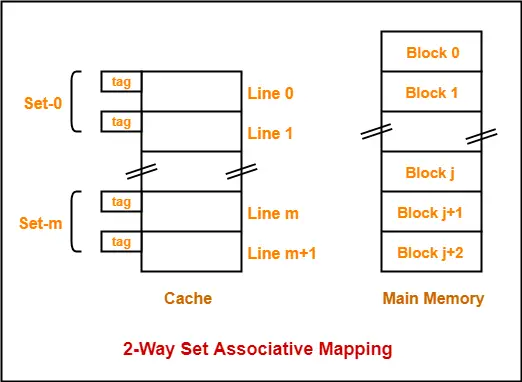Set Associative Mapping-
Before you go through this article, make sure that you have gone through the previous article on Set Associative Mapping.
In set associative mapping,
- A particular block of main memory can be mapped to one particular cache set only.
- Block ‘j’ of main memory will map to set number (j mod number of sets in cache) of the cache.
- A replacement algorithm is needed if the cache is full.
In this article, we will discuss practice problems based on set associative mapping.
Also Read- Cache Mapping Techniques
PRACTICE PROBLEMS BASED ON SET ASSOCIATIVE MAPPING-
Problem-01:
Consider a 2-way set associative mapped cache of size 16 KB with block size 256 bytes. The size of main memory is 128 KB. Find-
- Number of bits in tag
- Tag directory size
Solution-
Given-
- Set size = 2
- Cache memory size = 16 KB
- Block size = Frame size = Line size = 256 bytes
- Main memory size = 128 KB
We consider that the memory is byte addressable.
Number of Bits in Physical Address-
We have,
Size of main memory
= 128 KB
= 217 bytes
Thus, Number of bits in physical address = 17 bits

Number of Bits in Block Offset-
We have,
Block size
= 256 bytes
= 28 bytes
Thus, Number of bits in block offset = 8 bits

Number of Lines in Cache-
Total number of lines in cache
= Cache size / Line size
= 16 KB / 256 bytes
= 214 bytes / 28 bytes
= 64 lines
Thus, Number of lines in cache = 64 lines
Number of Sets in Cache-
Total number of sets in cache
= Total number of lines in cache / Set size
= 64 / 2
= 32 sets
= 25 sets
Thus, Number of bits in set number = 5 bits

Number of Bits in Tag-
Number of bits in tag
= Number of bits in physical address – (Number of bits in set number + Number of bits in block offset)
= 17 bits – (5 bits + 8 bits)
= 17 bits – 13 bits
= 4 bits
Thus, Number of bits in tag = 4 bits

Tag Directory Size-
Tag directory size
= Number of tags x Tag size
= Number of lines in cache x Number of bits in tag
= 64 x 4 bits
= 256 bits
= 32 bytes
Thus, size of tag directory = 32 bytes
Also Read- Practice Problems On Direct Mapping
Problem-02:
Consider a 8-way set associative mapped cache of size 512 KB with block size 1 KB. There are 7 bits in the tag. Find-
- Size of main memory
- Tag directory size
Solution-
Given-
- Set size = 8
- Cache memory size = 512 KB
- Block size = Frame size = Line size = 1 KB
- Number of bits in tag = 7 bits
We consider that the memory is byte addressable.
Number of Bits in Block Offset-
We have,
Block size
= 1 KB
= 210 bytes
Thus, Number of bits in block offset = 10 bits

Number of Lines in Cache-
Total number of lines in cache
= Cache size / Line size
= 512 KB / 1 KB
= 512 lines
Thus, Number of lines in cache = 512 lines
Number of Sets in Cache-
Total number of sets in cache
= Total number of lines in cache / Set size
= 512 / 8
= 64 sets
= 26 sets
Thus, Number of bits in set number = 6 bits

Number of Bits in Physical Address-
Number of bits in physical address
= Number of bits in tag + Number of bits in set number + Number of bits in block offset
= 7 bits + 6 bits + 10 bits
= 23 bits
Thus, Number of bits in physical address = 23 bits
Size of Main Memory-
We have,
Number of bits in physical address = 23 bits
Thus, Size of main memory
= 223 bytes
= 8 MB
Tag Directory Size-
Tag directory size
= Number of tags x Tag size
= Number of lines in cache x Number of bits in tag
= 512 x 7 bits
= 3584 bits
= 448 bytes
Thus, size of tag directory = 448 bytes
Problem-03:
Consider a 4-way set associative mapped cache with block size 4 KB. The size of main memory is 16 GB and there are 10 bits in the tag. Find-
- Size of cache memory
- Tag directory size
Solution-
Given-
- Set size = 4
- Block size = Frame size = Line size = 4 KB
- Main memory size = 16 GB
- Number of bits in tag = 10 bits
We consider that the memory is byte addressable.
Number of Bits in Physical Address-
We have,
Size of main memory
= 16 GB
= 234 bytes
Thus, Number of bits in physical address = 34 bits

Number of Bits in Block Offset-
We have,
Block size
= 4 KB
= 212 bytes
Thus, Number of bits in block offset = 12 bits

Number of Bits in Set Number-
Number of bits in set number
= Number of bits in physical address – (Number of bits in tag + Number of bits in block offset)
= 34 bits – (10 bits + 12 bits)
= 34 bits – 22 bits
= 12 bits
Thus, Number of bits in set number = 12 bits

Number of Sets in Cache-
We have-
Number of bits in set number = 12 bits
Thus, Total number of sets in cache = 212 sets
Number of Lines in Cache-
We have-
Total number of sets in cache = 212 sets
Each set contains 4 lines
Thus,
Total number of lines in cache
= Total number of sets in cache x Number of lines in each set
= 212 x 4 lines
= 214 lines
Size of Cache Memory-
Size of cache memory
= Total number of lines in cache x Line size
= 214 x 4 KB
= 216 KB
= 64 MB
Thus, Size of cache memory = 64 MB
Tag Directory Size-
Tag directory size
= Number of tags x Tag size
= Number of lines in cache x Number of bits in tag
= 214 x 10 bits
= 163840 bits
= 20480 bytes
= 20 KB
Thus, size of tag directory = 20 KB
Also Read- Practice Problems On Fully Associative Mapping
Problem-04:
Consider a 8-way set associative mapped cache. The size of cache memory is 512 KB and there are 10 bits in the tag. Find the size of main memory.
Solution-
Given-
- Set size = 8
- Cache memory size = 512 KB
- Number of bits in tag = 10 bits
We consider that the memory is byte addressable.
Let-
- Number of bits in set number field = x bits
- Number of bits in block offset field = y bits

Sum of Number Of Bits Of Set Number Field And Block Offset Field-
We have,
Cache memory size = Number of sets in cache x Number of lines in one set x Line size
Now, substituting the values, we get-
512 KB = 2x x 8 x 2y bytes
219 bytes = 23+x+y bytes
19 = 3 +x + y
x + y = 19 – 3
x + y = 16
Number of Bits in Physical Address-
Number of bits in physical address
= Number of bits in tag + Number of bits in set number + Number of bits in block offset
= 10 bits + x bits + y bits
= 10 bits + (x + y) bits
= 10 bits + 16 bits
= 26 bits
Thus, Number of bits in physical address = 26 bits

Size of Main Memory-
We have,
Number of bits in physical address = 26 bits
Thus, Size of main memory
= 226 bytes
= 64 MB
Thus, size of main memory = 64 MB
Problem-05:
Consider a 4-way set associative mapped cache. The size of main memory is 64 MB and there are 10 bits in the tag. Find the size of cache memory.
Solution-
Given-
- Set size = 4
- Main memory size = 64 MB
- Number of bits in tag = 10 bits
We consider that the memory is byte addressable.
Number of Bits in Physical Address-
We have,
Size of main memory
= 64 MB
= 226 bytes
Thus, Number of bits in physical address = 26 bits

Sum Of Number Of Bits Of Set Number Field And Block Offset Field-
Let-
- Number of bits in set number field = x bits
- Number of bits in block offset field = y bits

Then, Number of bits in physical address
= Number of bits in tag + Number of bits in set number + Number of bits in block offset
So, we have-
26 bits = 10 bits + x bits + y bits
26 = 10 + (x + y)
x + y = 26 – 10
x + y = 16
Thus, Sum of number of bits of set number field and block offset field = 16 bits
Size of Cache Memory-
Cache memory size
= Number of sets in cache x Number of lines in one set x Line size
= 2x x 4 x 2y bytes
= 22+x+y bytes
= 22+16 bytes
= 218 bytes
= 256 KB
Thus, size of cache memory = 256 KB
To watch video solutions and practice more problems,
Next Article- Miscellaneous Practice Problems On Cache Mapping Techniques
Get more notes and other study material of Computer Organization and Architecture.
Watch video lectures by visiting our YouTube channel LearnVidFun.

